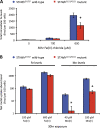Altered manganese homeostasis and manganese toxicity in a Huntington's disease striatal cell model are not explained by defects in the iron transport system
- PMID: 20547568
- PMCID: PMC2923282
- DOI: 10.1093/toxsci/kfq174
Altered manganese homeostasis and manganese toxicity in a Huntington's disease striatal cell model are not explained by defects in the iron transport system
Abstract
Expansion of a polyglutamine tract in Huntingtin (Htt) leads to the degeneration of medium spiny neurons in Huntington's disease (HD). Furthermore, the HTT gene has been functionally linked to iron (Fe) metabolism, and HD patients show alterations in brain and peripheral Fe homeostasis. Recently, we discovered that expression of mutant HTT is associated with impaired manganese (Mn) uptake following overexposure in a striatal neuronal cell line and mouse model of HD. Here we test the hypothesis that the transferrin receptor (TfR)-mediated Fe uptake pathway is responsible for the HD-associated defects in Mn uptake. Western blot analysis showed that TfR levels are reduced in the mutant STHdh(Q111/Q111) striatal cell line, whereas levels of the Fe and Mn transporter, divalent metal transporter 1 (DMT1), are unchanged. To stress the Fe transport system, we exposed mutant and wild-type cells to elevated Fe(III), which revealed a subtle impairment in net Fe uptake only at the highest Fe exposures. In contrast, the HD mutant line exhibited substantial deficits in net Mn uptake, even under basal conditions. Finally, to functionally evaluate a role for Fe transporters in the Mn uptake deficit, we examined Mn toxicity in the presence of saturating Fe(III) levels. Although Fe(III) exposure decreased Mn neurotoxicity, it did so equally for wild-type and mutant cells. Therefore, although Fe transporters contribute to Mn uptake and toxicity in the striatal cell lines, functional alterations in this pathway are insufficient to explain the strong Mn resistance phenotype of this HD cell model.
Figures






Similar articles
-
Novel high-throughput assay to assess cellular manganese levels in a striatal cell line model of Huntington's disease confirms a deficit in manganese accumulation.Neurotoxicology. 2011 Oct;32(5):630-9. doi: 10.1016/j.neuro.2011.01.002. Epub 2011 Jan 14. Neurotoxicology. 2011. PMID: 21238486 Free PMC article.
-
Differential proteomic and genomic profiling of mouse striatal cell model of Huntington's disease and control; probable implications to the disease biology.J Proteomics. 2016 Jan 30;132:155-66. doi: 10.1016/j.jprot.2015.11.007. Epub 2015 Nov 12. J Proteomics. 2016. PMID: 26581643
-
Full length mutant huntingtin is required for altered Ca2+ signaling and apoptosis of striatal neurons in the YAC mouse model of Huntington's disease.Neurobiol Dis. 2008 Jul;31(1):80-8. doi: 10.1016/j.nbd.2008.03.010. Epub 2008 Apr 16. Neurobiol Dis. 2008. PMID: 18502655 Free PMC article.
-
Manganese and the Insulin-IGF Signaling Network in Huntington's Disease and Other Neurodegenerative Disorders.Adv Neurobiol. 2017;18:113-142. doi: 10.1007/978-3-319-60189-2_6. Adv Neurobiol. 2017. PMID: 28889265 Free PMC article. Review.
-
Selective degeneration in YAC mouse models of Huntington disease.Brain Res Bull. 2007 Apr 30;72(2-3):124-31. doi: 10.1016/j.brainresbull.2006.10.018. Epub 2006 Nov 16. Brain Res Bull. 2007. PMID: 17352936 Review.
Cited by
-
Mechanisms of lead and manganese neurotoxicity.Toxicol Res (Camb). 2013 Mar 1;2(2):99-114. doi: 10.1039/C2TX20064C. Toxicol Res (Camb). 2013. PMID: 25722848 Free PMC article.
-
Identification of Three Small Molecules That Can Selectively Influence Cellular Manganese Levels in a Mouse Striatal Cell Model.Molecules. 2021 Feb 22;26(4):1175. doi: 10.3390/molecules26041175. Molecules. 2021. PMID: 33671818 Free PMC article.
-
Untargeted metabolic profiling identifies interactions between Huntington's disease and neuronal manganese status.Metallomics. 2015 Feb;7(2):363-70. doi: 10.1039/c4mt00223g. Metallomics. 2015. PMID: 25599126 Free PMC article.
-
Mechanisms of Metal-Induced Mitochondrial Dysfunction in Neurological Disorders.Toxics. 2021 Jun 17;9(6):142. doi: 10.3390/toxics9060142. Toxics. 2021. PMID: 34204190 Free PMC article. Review.
-
A novel manganese-dependent ATM-p53 signaling pathway is selectively impaired in patient-based neuroprogenitor and murine striatal models of Huntington's disease.Hum Mol Genet. 2015 Apr 1;24(7):1929-44. doi: 10.1093/hmg/ddu609. Epub 2014 Dec 8. Hum Mol Genet. 2015. PMID: 25489053 Free PMC article.
References
-
- Anderson J, Fordahl S, Cooney P, Weaver T, Colyer C, Erikson K. Extracellular norepinephrine, norepinephrine receptor and transporter protein and mRNA levels are differentially altered in the developing rat brain due to dietary iron deficiency and manganese exposure. Brain Res. 2009;1281:1–14. - PMC - PubMed
-
- Andreassen O, Ferrante R, Dedeoglu A, Albers D, Klivenyi P, Carlson E, Epstein C, Beal M. Mice with a partial deficiency of manganese superoxide dismutase show increased vulnerability to the mitochondrial toxins malonate, 3-nitropropionic acid, and MPTP. Exp. Neurol. 2001;167:189–195. - PubMed
-
- Applebury M, Johnson B, Coleman J. Phosphate binding to alkaline phosphatase. Metal ion dependence. J. Biol. Chem. 1970;245:4968–4976. - PubMed
-
- Aschner M, Erikson K, Dorman D. Manganese dosimetry: species differences and implications for neurotoxicity. Crit. Rev. Toxicol. 2005;35:1–32. - PubMed
-
- Aschner M, Gannon M. Manganese (Mn) transport across the rat blood-brain barrier: saturable and transferrin-dependent transport mechanisms. Brain Res. Bull. 1994;33:345–349. - PubMed
Publication types
MeSH terms
Substances
Grants and funding
LinkOut - more resources
Full Text Sources
Medical

